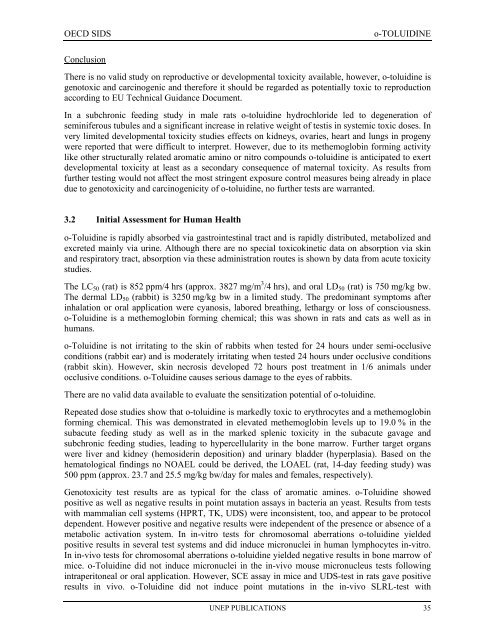o-TOLUIDINE CAS N°: 95-53-4 - UNEP Chemicals
o-TOLUIDINE CAS N°: 95-53-4 - UNEP Chemicals
o-TOLUIDINE CAS N°: 95-53-4 - UNEP Chemicals
You also want an ePaper? Increase the reach of your titles
YUMPU automatically turns print PDFs into web optimized ePapers that Google loves.
OECD SIDS o-<strong>TOLUIDINE</strong><br />
Conclusion<br />
There is no valid study on reproductive or developmental toxicity available, however, o-toluidine is<br />
genotoxic and carcinogenic and therefore it should be regarded as potentially toxic to reproduction<br />
according to EU Technical Guidance Document.<br />
In a subchronic feeding study in male rats o-toluidine hydrochloride led to degeneration of<br />
seminiferous tubules and a significant increase in relative weight of testis in systemic toxic doses. In<br />
very limited developmental toxicity studies effects on kidneys, ovaries, heart and lungs in progeny<br />
were reported that were difficult to interpret. However, due to its methemoglobin forming activity<br />
like other structurally related aromatic amino or nitro compounds o-toluidine is anticipated to exert<br />
developmental toxicity at least as a secondary consequence of maternal toxicity. As results from<br />
further testing would not affect the most stringent exposure control measures being already in place<br />
due to genotoxicity and carcinogenicity of o-toluidine, no further tests are warranted.<br />
3.2 Initial Assessment for Human Health<br />
o-Toluidine is rapidly absorbed via gastrointestinal tract and is rapidly distributed, metabolized and<br />
excreted mainly via urine. Although there are no special toxicokinetic data on absorption via skin<br />
and respiratory tract, absorption via these administration routes is shown by data from acute toxicity<br />
studies.<br />
The LC50 (rat) is 852 ppm/4 hrs (approx. 3827 mg/m 3 /4 hrs), and oral LD50 (rat) is 750 mg/kg bw.<br />
The dermal LD50 (rabbit) is 3250 mg/kg bw in a limited study. The predominant symptoms after<br />
inhalation or oral application were cyanosis, labored breathing, lethargy or loss of consciousness.<br />
o-Toluidine is a methemoglobin forming chemical; this was shown in rats and cats as well as in<br />
humans.<br />
o-Toluidine is not irritating to the skin of rabbits when tested for 24 hours under semi-occlusive<br />
conditions (rabbit ear) and is moderately irritating when tested 24 hours under occlusive conditions<br />
(rabbit skin). However, skin necrosis developed 72 hours post treatment in 1/6 animals under<br />
occlusive conditions. o-Toluidine causes serious damage to the eyes of rabbits.<br />
There are no valid data available to evaluate the sensitization potential of o-toluidine.<br />
Repeated dose studies show that o-toluidine is markedly toxic to erythrocytes and a methemoglobin<br />
forming chemical. This was demonstrated in elevated methemoglobin levels up to 19.0 % in the<br />
subacute feeding study as well as in the marked splenic toxicity in the subacute gavage and<br />
subchronic feeding studies, leading to hypercellularity in the bone marrow. Further target organs<br />
were liver and kidney (hemosiderin deposition) and urinary bladder (hyperplasia). Based on the<br />
hematological findings no NOAEL could be derived, the LOAEL (rat, 14-day feeding study) was<br />
500 ppm (approx. 23.7 and 25.5 mg/kg bw/day for males and females, respectively).<br />
Genotoxicity test results are as typical for the class of aromatic amines. o-Toluidine showed<br />
positive as well as negative results in point mutation assays in bacteria an yeast. Results from tests<br />
with mammalian cell systems (HPRT, TK, UDS) were inconsistent, too, and appear to be protocol<br />
dependent. However positive and negative results were independent of the presence or absence of a<br />
metabolic activation system. In in-vitro tests for chromosomal aberrations o-toluidine yielded<br />
positive results in several test systems and did induce micronuclei in human lymphocytes in-vitro.<br />
In in-vivo tests for chromosomal aberrations o-toluidine yielded negative results in bone marrow of<br />
mice. o-Toluidine did not induce micronuclei in the in-vivo mouse micronucleus tests following<br />
intraperitoneal or oral application. However, SCE assay in mice and UDS-test in rats gave positive<br />
results in vivo. o-Toluidine did not induce point mutations in the in-vivo SLRL-test with<br />
<strong>UNEP</strong> PUBLICATIONS 35
















